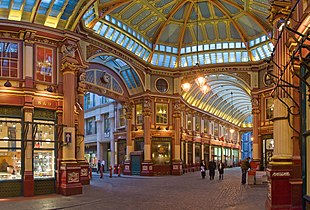Leadenhall Market
Leadenhall Market is a covered market in the City of London that has been a Grade II * listed building since 1972 .
As early as the 14th century, poultry and cheese traders met around Leadenhall Manor. In 1463 he was given the right to weigh in wool, and in 1488 a monopoly on the trade in leather. Large parts of the market were also destroyed in the great fire of London in 1666. The long-term provisional that was subsequently built was rebuilt in 1881 by Sir Horace Jones , who also designed Billingsgate Market and Smithfield Market . A roof made of cast iron and glass has spanned the previous stone buildings since then. In 1991 Leadenhall Market was extensively restored.
Today the market is home to fish, meat, cheese and other grocery and delicatessen shops, wine shops, florists, hairdressers, restaurants and bars. The hall is open every day, the shops are open Monday to Friday from 7:00 a.m. and are frequented by both the city's population and tourists.
Trivia
The goose "Old Tom" is buried with a memorial stone in the market. She is said to have escaped being slaughtered several times and thus became a local celebrity. She was regularly fed by the stallholders until she died in 1835 at the age of 38.
The Diagon Alley scenes in the first film in the Harry Potter series, Harry Potter and the Philosopher's Stone , were filmed at Leadenhall Market in 2001.
Web links
Coordinates: 51 ° 30 '45.7 " N , 0 ° 5' 2.6" W.


